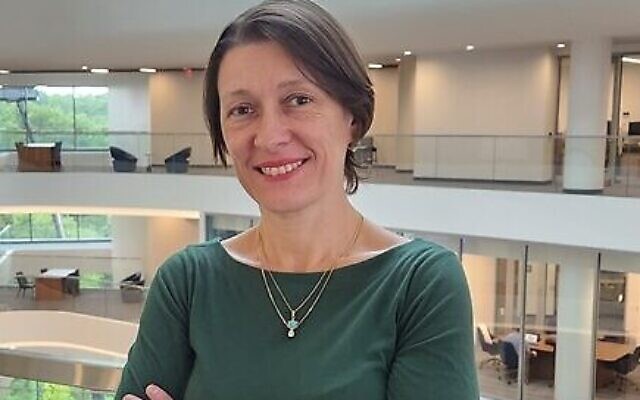Royak Aims to Tackle Alzheimer’s via Vaccine
Working with mice, Yona Royak strives to develop a gene therapy vaccine to prevent toxic protein accumulation in the brain.
After 37 years with the Atlanta Journal-Constitution and now with the AJT, , Jaffe’s focus is lifestyle, art, dining, fashion, and community events with emphasis on Jewish movers and shakers.

Yona Royak-Czesler, associate professor in the Department of Pharmacology and Chemical Biology and a member of the Center for Neurodegenerative Diseases, came to Emory University in 2022. Her research involves development of potential therapies to diseases that involve accumulation of toxic proteins in the brain, such as Alzheimer’s, Parkinson’s, and ALS.
Her aim is to devise a vaccine that will prevent or even clear these accumulations and deliver it via gene therapy. Royak said, “This research is still very preliminary and so far, we are able to ‘cure’ mice that have a similar pathology, and even in the case of these mice, we need to administer the therapy early in the course of the disease. Thus, some of my projects involve optimizing the therapy as well as optimizing the route of delivery.”
The media is consumed with cutting edge potential cures, against which Royak cautions, “Because the field of Alzheimer’s research is lacking Earth-shuttering discoveries of magic drugs, journalists tend to jump preclinical studies that have potential, and it goes viral, way before there is solid evidence.”
She added that it’s believed that the culprit is a small protein Amyloid beta that forms aggregates in the brain, which leads to a chain of toxic processes, that result in the death of brain cells, and as a result, in brain organ failure. This process is lengthy and possibly starts way before the symptoms appear, 20-30 years prior.
This means that a search for better diagnostics, blood biomarkers, and imaging is crucial in predicting who will get the disease. There is also discussion of proteins other than Amyloid as additional targets. One of Royak’s projects, funded by the National Institutes of Health, is examining the role these proteins play in cell culture and mouse models.
Recently on CBS, “60 Minutes” (Jan. 14, 2024), a West Virginia physician showed procedures which looked very hopeful where he tediously routed the bad plaque. Royak commented, “Focused ultrasound approach, combined with antibody treatment, showed some benefits, but the study was done in three patients, so it’s early to make any solid conclusions.”
Alzheimer’s afflicts more than six million Americans aged 65 and older. The disease causes patients to slowly lose the ability to handle daily tasks. Beyond memory loss and confusion, they have difficulty with navigation, grocery shopping, bill paying, self-care, motivation, balance and, in late stages, walking and swallowing.
Royak explains, “Current treatment options are limited. Some people see temporary improvement in cognitive function and memory using medications, but these don’t stop the disease from progressing. The cost in unpaid dementia caregiving by family and friends was valued by the Alzheimer’s Association at $256.7 billion in 2020. Age is the biggest risk factor of Alzheimer’s disease, and the chances to have it as we age are growing exponentially.”
Nevertheless, Royak has observed “superagers,” in their 90s to 100s, who have no symptoms. Researchers look for reasons these people are “protected,” genetically and environmentally. So far, only education, healthy heart, healthy weight, and physical activity correlate with better outcomes.
As interesting personal history, Yona was born to a family of refuseniks in Bendery, Moldova, a small town which was predominantly Jewish at the turn of the 20th century. When the USSR invaded Bessarabia and annexed Moldova in 1940, and after World War II, it was a mix of Russians, Ukrainians, Moldavians, Jews, and others.
Nevertheless, Royak has observed ‘superagers,’ in their 90s to 100s, who have no symptoms. Researchers look for reasons these people are ‘protected,’ genetically and environmentally. So far, only education, healthy heart, healthy weight, and physical activity correlate with better outcomes.
She elaborated, “Life in Moldova was very similar to life in any of the other Soviet republics behind the Iron Curtain – poor, simple, with limited to no access to the first world comforts or information.”
Her parents studied Hebrew and celebrated Jewish holidays; but it was illegal, and they were persecuted. In 1988, with Mikhail Gorbachev’s reforms and the further fall of the Soviet Union, the family left for Israel. She went to high school in Haifa, served 2.5 years in IDF, completed undergraduate and graduate studies in Technion, and received a PhD in neuroscience in 2002 when she immigrated to the U.S. to pursue her postdoctoral fellowship at Mayo Clinic Jacksonville.
After a faculty position at the University of Florida Department of Neuroscience, she joined Emory where she mentors undergraduate and graduate students, and post docs.
- Senior Living
- Health and Wellness
- Marcia Caller Jaffe
- Yona Royak-Czesler
- Department of Pharmacology and Chemical Biology
- Center for Neurodegenerative Diseases
- Emory University
- Alzheimer's
- Parkinson's
- and ALS
- National Institutes of Health
- 60 Minutes
- superagers
- Bendery
- Moldova
- refuseniks
- Bessarabia
- World War II
- Mikhail Gorbachev
- Technion
- Haifa
- University of Florida Department of Neuroscience
- Alzheimer's Association



comments